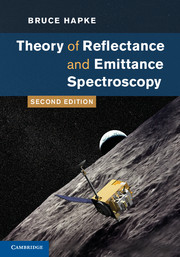Book contents
- Frontmatter
- Contents
- Acknowledgments
- 1 Introduction
- 2 Electromagnetic wave propagation
- 3 The absorption of light
- 4 Specular reflection
- 5 Single-particle scattering: perfect spheres
- 6 Single-particle scattering: irregular particles
- 7 Propagation in a nonuniform medium: the equation of radiative transfer
- 8 The bidirectional reflectance of a semi-infinite medium
- 9 The opposition effect
- 10 A miscellany of bidirectional reflectances and related quantities
- 11 Integrated reflectances and planetary photometry
- 12 Photometric effects of large-scale roughness
- 13 Polarization of light scattered by a particulate medium
- 14 Reflectance spectroscopy
- 15 Thermal emission and emittance spectroscopy
- 16 Simultaneous transport of energy by radiation and thermal conduction
- Appendix A A brief review of vector calculus
- Appendix B Functions of a complex variable
- Appendix C The wave equation in spherical coordinates
- Appendix D Fraunhofer diffraction by a circular hole
- Appendix E Table of symbols
- Bibliography
- Index
14 - Reflectance spectroscopy
Published online by Cambridge University Press: 05 January 2012
- Frontmatter
- Contents
- Acknowledgments
- 1 Introduction
- 2 Electromagnetic wave propagation
- 3 The absorption of light
- 4 Specular reflection
- 5 Single-particle scattering: perfect spheres
- 6 Single-particle scattering: irregular particles
- 7 Propagation in a nonuniform medium: the equation of radiative transfer
- 8 The bidirectional reflectance of a semi-infinite medium
- 9 The opposition effect
- 10 A miscellany of bidirectional reflectances and related quantities
- 11 Integrated reflectances and planetary photometry
- 12 Photometric effects of large-scale roughness
- 13 Polarization of light scattered by a particulate medium
- 14 Reflectance spectroscopy
- 15 Thermal emission and emittance spectroscopy
- 16 Simultaneous transport of energy by radiation and thermal conduction
- Appendix A A brief review of vector calculus
- Appendix B Functions of a complex variable
- Appendix C The wave equation in spherical coordinates
- Appendix D Fraunhofer diffraction by a circular hole
- Appendix E Table of symbols
- Bibliography
- Index
Summary
Introduction
One of the objectives of studying a planet by reflectance is to infer various properties of the surface by inverting a set of remote measurements. In the laboratory, the objective of a reflectance measurement is usually to determine the spectral absorption coefficient of the material, or at least some quantity proportional to it, by inversion of the spectral reflectance.
For several reasons reflectance spectroscopy is a powerful technique for measuring the characteristic absorption spectrum of a particulate material. The dynamic range of the measurement is extremely large. Multiple scattering amplifies the contrast within weak absorption bands in the light transmitted through the particles, while strong bands can be detected by anomalous dispersion in the radiation reflected from the particle surfaces. Hence, the measurement of a single spectrum can give information on the spectral absorption coefficient over a range of several orders of magnitude in α. This is especially true for the range ni = 10-3 - 10-1, where both transmission and reflection techniques are difficult. Another advantage of reflectance methods is that sample preparation is convenient and simply requires grinding the material to the desired degree of fineness and sieving it to constrain the particle size. By contrast, if α(λ) is measured by transmission, the sample must be sliced into a thin section that must then be polished on both sides, and the range by which α(λ) can vary is not much more than about one order of magnitude.
- Type
- Chapter
- Information
- Theory of Reflectance and Emittance Spectroscopy , pp. 369 - 411Publisher: Cambridge University PressPrint publication year: 2012
- 2
- Cited by



